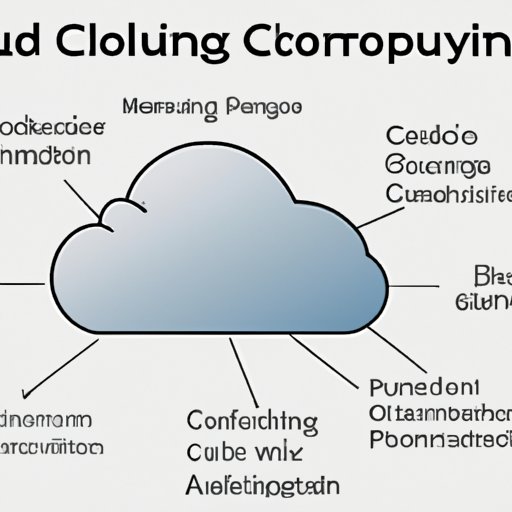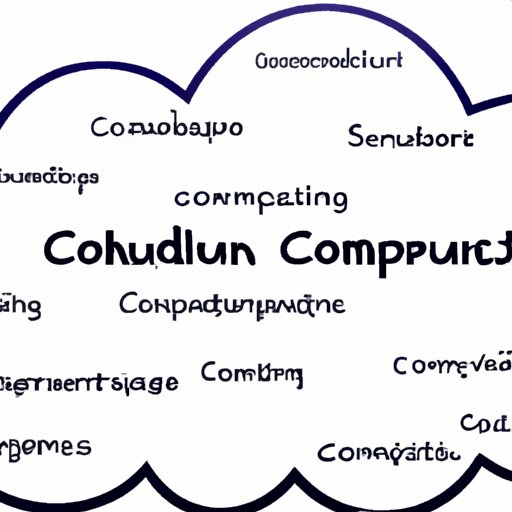Introduction
Cloud computing has revolutionized the way businesses operate, allowing them to access data and applications anywhere in the world through a secure online connection. But what exactly is the cloud, and how does it work? This article will explore the basics of cloud computing, including what it is, its various types and benefits, components, models, services, deployment, cost, strategies, infrastructure, technologies, security, implementation and challenges.
A Beginner’s Guide to the Cloud: What is it and How Does it Work?
Cloud computing is a distributed computing model that allows users to access applications, data, and other resources over the internet. It provides organizations with the flexibility to access their data from any device, at any time, without having to install software or hardware on-site. The cloud can be used for a variety of tasks, from creating documents and spreadsheets to running complex business applications.
At its core, cloud computing is a set of computer, networking, and storage services that are delivered over the internet. These services can be accessed through a web browser or mobile device, and can provide users with a variety of benefits such as increased scalability, reliability, and cost savings.
Overview of Types of Cloud Computing
There are three main types of cloud computing: public cloud, private cloud, and hybrid cloud. Public clouds are owned and operated by a third-party provider, such as Amazon Web Services or Microsoft Azure. Private clouds are hosted on-site or off-site and are typically managed by an organization’s IT department. Hybrid clouds combine elements of both public and private clouds, allowing organizations to use the best of both worlds.
Advantages of Using the Cloud
One of the key advantages of using the cloud is the ability to scale up or down as needed. Organizations can easily add new servers, storage, and applications to meet their needs without having to invest in additional hardware or software. Additionally, cloud computing can provide organizations with more reliable service than traditional on-premise solutions, as cloud providers have redundant systems and multiple backups to ensure the highest levels of uptime.
Another benefit of the cloud is that it can reduce costs. By eliminating the need to purchase and maintain expensive hardware, organizations can save money on upfront capital investments, as well as ongoing maintenance and support costs. Additionally, cloud computing can free up IT staff to focus on more strategic initiatives, rather than spending time managing hardware and software.
Understanding the Different Components of Cloud Computing
The cloud is composed of several components, including hardware, software, and networks. The hardware component consists of physical servers, storage devices, and networking equipment. The software component includes operating systems, databases, and applications. The network component includes the internet, intranets, and virtual private networks (VPNs). Together, these components allow users to access applications, data, and other resources from any device, at any time.
Exploring the World of Cloud Computing: What is it and How Does it Work?
In addition to the hardware, software, and networks that make up the cloud, there are also several different models and services that are used to deliver cloud computing. These include Infrastructure as a Service (IaaS), Platform as a Service (PaaS), and Software as a Service (SaaS). IaaS provides users with access to virtualized computing resources, such as servers, storage, and networking. PaaS provides users with access to development tools, such as databases, application servers, and other software development kits. SaaS provides users with access to applications, such as customer relationship management (CRM) and email, that are hosted in the cloud.
Benefits of Cloud Computing
Cloud computing offers many benefits to organizations, including increased scalability, agility, and cost savings. With cloud computing, organizations can quickly and easily scale up or down as needed, reducing the amount of time spent on provisioning and configuring hardware and software. Additionally, cloud computing can provide organizations with greater agility, allowing them to quickly deploy new applications or services without having to wait for hardware or software to be installed and configured.
Cloud computing can also help organizations reduce costs. By eliminating the need to purchase and maintain expensive hardware and software, organizations can save money on upfront capital investments, as well as ongoing maintenance and support costs. Additionally, cloud computing can free up IT staff to focus on more strategic initiatives, rather than spending time managing hardware and software.
Understanding the Different Models of Cloud Computing
There are several different models of cloud computing, each of which offers different benefits and considerations. The most common models are public clouds, private clouds, and hybrid clouds. Public clouds are owned and operated by a third-party provider, such as Amazon Web Services or Microsoft Azure. Private clouds are hosted on-site or off-site and are typically managed by an organization’s IT department. Hybrid clouds combine elements of both public and private clouds, allowing organizations to use the best of both worlds.
Security Considerations When Utilizing the Cloud
When utilizing the cloud, organizations must consider a number of security considerations. These include ensuring that all data is encrypted, implementing multi-factor authentication, and regularly monitoring the cloud environment for suspicious activity. Additionally, organizations should ensure that they have adequate backup and disaster recovery plans in place to protect their data in the event of an outage or attack.
Cloud Computing 101: Understanding the Basics of the Cloud
Cloud computing is a powerful tool that can enable organizations to become more agile, efficient, and secure. To get started with cloud computing, organizations must first understand the different types of cloud services and their various features and benefits. Additionally, organizations should consider the different deployment models of cloud computing, as well as the associated costs and security measures.
Overview of Cloud Services
Cloud services are divided into three categories: Infrastructure as a Service (IaaS), Platform as a Service (PaaS), and Software as a Service (SaaS). IaaS provides users with access to virtualized computing resources, such as servers, storage, and networking. PaaS provides users with access to development tools, such as databases, application servers, and other software development kits. SaaS provides users with access to applications, such as customer relationship management (CRM) and email, that are hosted in the cloud.
Understanding the Different Deployment Models of Cloud Computing
Organizations must also consider the different deployment models of cloud computing when selecting a cloud provider. The most common models are public clouds, private clouds, and hybrid clouds. Public clouds are owned and operated by a third-party provider, such as Amazon Web Services or Microsoft Azure. Private clouds are hosted on-site or off-site and are typically managed by an organization’s IT department. Hybrid clouds combine elements of both public and private clouds, allowing organizations to use the best of both worlds.
Cost Considerations When Utilizing the Cloud
Organizations should also consider the cost implications when utilizing the cloud. Cloud services are typically priced on a pay-as-you-go basis, meaning organizations only pay for the services they use. Additionally, many cloud providers offer discounts and other incentives to encourage organizations to utilize their services. Organizations should carefully consider the total cost of ownership before selecting a cloud provider.
The Cloud for Dummies: What is it and How Does it Work?
Cloud computing is a powerful tool that can enable organizations to become more agile, efficient, and secure. To get the most out of the cloud, organizations must understand the different types of cloud services and their various features and benefits, as well as the different deployment models, cost considerations, and security measures.
Overview of the Different Benefits of Cloud Computing
Cloud computing offers many benefits to organizations, including increased scalability, agility, and cost savings. With cloud computing, organizations can quickly and easily scale up or down as needed, reducing the amount of time spent on provisioning and configuring hardware and software. Additionally, cloud computing can provide organizations with greater agility, allowing them to quickly deploy new applications or services without having to wait for hardware or software to be installed and configured.
Understanding the Different Types of Cloud Computing
There are several different types of cloud computing, each of which offers different benefits and considerations. The most common types are public clouds, private clouds, and hybrid clouds. Public clouds are owned and operated by a third-party provider, such as Amazon Web Services or Microsoft Azure. Private clouds are hosted on-site or off-site and are typically managed by an organization’s IT department. Hybrid clouds combine elements of both public and private clouds, allowing organizations to use the best of both worlds.
Understanding the Different Strategies for Leveraging the Cloud
Organizations must also consider the different strategies for leveraging the cloud. These include moving existing applications to the cloud, building new applications in the cloud, and leveraging cloud-based services. Additionally, organizations should consider the different cost models of cloud services, such as pay-as-you-go or subscription-based pricing.

Demystifying the Cloud: An Overview of What it is and How it Functions
Cloud computing is a powerful tool that can enable organizations to become more agile, efficient, and secure. To get the most out of the cloud, organizations must understand the different types of cloud services, deployment models, cost considerations, security measures, and strategies for leveraging the cloud.
Overview of Cloud Infrastructure
The cloud is composed of several components, including hardware, software, and networks. The hardware component consists of physical servers, storage devices, and networking equipment. The software component includes operating systems, databases, and applications. The network component includes the internet, intranets, and virtual private networks (VPNs). Together, these components allow users to access applications, data, and other resources from any device, at any time.
Understanding the Different Technologies Involved in Cloud Computing
In addition to the hardware, software, and networks that make up the cloud, there are also several different technologies involved in cloud computing. These include virtualization, containerization, serverless computing, and artificial intelligence (AI). Virtualization enables organizations to run multiple virtual machines on a single physical machine, while containerization allows organizations to package and deploy applications quickly and easily. Serverless computing enables organizations to run code without the need for a server, and AI enables organizations to automate and optimize processes.
Challenges of Implementing Cloud Computing
When implementing cloud computing, organizations must also consider the potential challenges. These include ensuring that data is secure, managing costs, and dealing with vendor lock-in. Additionally, organizations must consider the different regulatory requirements, such as data privacy laws, when utilizing cloud services.

Cloud Computing Basics: Understanding What the Cloud is and How it Works
Cloud computing is a distributed computing model that allows users to access applications, data, and other resources over the internet. It provides organizations with the flexibility to access their data from any device, at any time, without having to install software or hardware on-site. In order to leverage the full power of the cloud, organizations must understand the different types of cloud services, deployment models, cost considerations, security measures, and strategies for leveraging the cloud.
Conclusion
Cloud computing is a powerful tool that can enable organizations to become more agile, efficient, and secure. By understanding the different types of cloud services, deployment models, cost considerations, security measures, and strategies for leveraging the cloud, organizations can take full advantage of the many benefits of cloud computing.
(Note: Is this article not meeting your expectations? Do you have knowledge or insights to share? Unlock new opportunities and expand your reach by joining our authors team. Click Registration to join us and share your expertise with our readers.)
